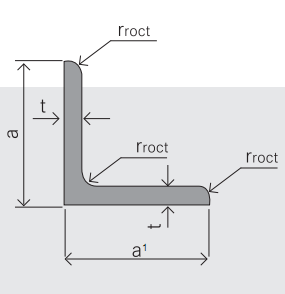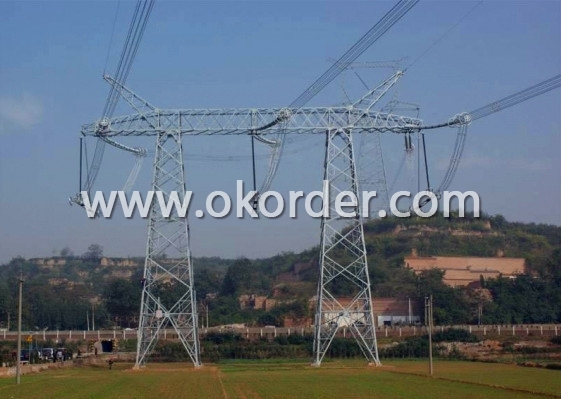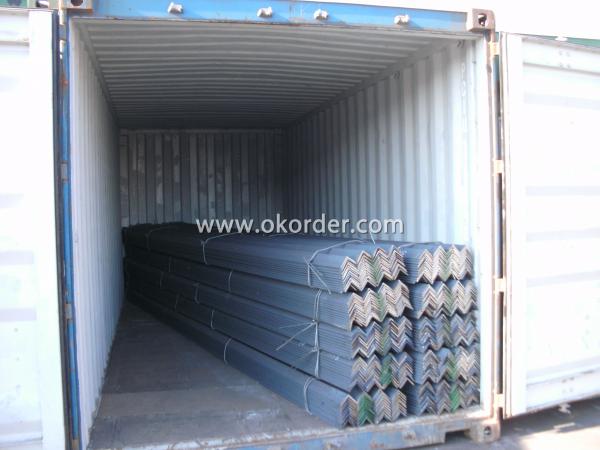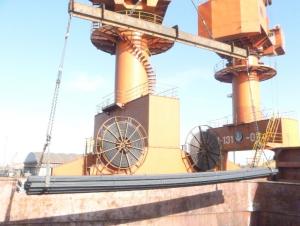Steel Equal Angle
- Loading Port:
- China Main Port
- Payment Terms:
- TT or LC
- Min Order Qty:
- 25 m.t.
- Supply Capability:
- 50000 m.t./month
OKorder Service Pledge
OKorder Financial Service
You Might Also Like
Specifications of Equal Angle
1. Standards: GB,ASTM,BS,AISI,DIN,JIS
2. Length:6m,9m,12m
3. Material: GB Q235B, Q345B or Equivalent; ASTM A36; EN 10025, S235JR, S355JR; JIS G3192, SS400; SS540.
4. Sizes:

Sizes: 25mm-250mm | ||
a*t | ||
25*2.5-4.0 | 70*6.0-9.0 | 130*9.0-15 |
30*2.5-6.6 | 75*6.0-9.0 | 140*10-14 |
36*3.0-5.0 | 80*5.0-10 | 150*10-20 |
38*2.3-6.0 | 90*7.0-10 | 160*10-16 |
40*3.0-5.0 | 100*6.0-12 | 175*12-15 |
45*4.0-6.0 | 110*8.0-10 | 180*12-18 |
50*4.0-6.0 | 120*6.0-15 | 200*14-25 |
60*4.0-8.0 | 125*8.0-14 | 250*25 |
5. Chemical data: %
C | Mn | S | P | Si |
0.14-0.22 | 0.30-0.65 | ≤0.050 | ≤0.045 | ≤0.30 |
Usage & Applications of Equal Angle
Trusses;
Transmission towers;
Telecommunication towers;
Bracing for general structures;
Stiffeners in structural use.
Products Advantages:
1. Convenient in construction and save much time and labor.
2. Light, good quality and reasonable price.
3. The shape and specification can be made by customer's requirement.
4. High mechanical strength.
5. Attractive in appearance and reasonable designs.

Packaging & Delivery of Equal Angle
1. Transportation: the goods are delivered by truck from mill to loading port, the maximum quantity can be loaded is around 40MTs by each truck. If the order quantity cannot reach the full truck loaded, the transportation cost per ton will be little higher than full load.
2. With bundles and load in 20 feet/40 feet container, or by bulk cargo, also we could do as customer's request.
3. Marks:
Color mark: There will be color marking on both end of the bundle for the cargo delivered by bulk vessel. That makes it easily to distinguish at the destination port.
Tag mark: There will be tag mark tied up on the bundles. The information usually including supplier logo and name, product name, made in China, shipping marks and other information request by the customer.
If loading by container the marking is not needed, but we will prepare it as customer request.
Images of Equal Angle



- Q:Can steel angles be used for architectural purposes?
- Certainly, steel angles can be utilized for architectural purposes. These versatile structural components find application in a myriad of architectural scenarios. Their primary function often involves providing crucial support and stability during building construction. For example, steel angles are employed as lintels or beams, effectively bearing the weight of walls, roofs, or floors. Furthermore, they serve as columns or braces, bolstering the overall structural integrity of a building. Moreover, steel angles can serve as decorative elements within architectural designs, imparting a contemporary and industrial aesthetic to the structure as a whole. Architects and engineers frequently opt for steel angles due to their robustness, resilience, and malleability when designing and erecting buildings.
- Q:What are the different types of steel angles used in shelving units?
- Shelving units commonly utilize various types of steel angles. The most basic type is the L-shaped angle, which forms the frame of the unit with its 90-degree angle. Slotted angles, on the other hand, resemble L-shaped angles but possess holes or slots along their length. These openings allow for convenient adjustment of shelving height and flexibility in configuration. Equal angles, featuring legs of equal length, are commonly found in shelving units with steel or heavy-material shelves. They provide extra strength and support to the shelves. Unequal angles, with legs of different lengths, are often used in shelving units housing lighter materials like wood or plastic. These angles ensure stability and prevent shelf sagging under the weight of items. Slotted equal angles combine the adjustability of slotted angles with the added strength of equal angles. They are frequently employed in shelving units that require both adjustability and strength. Ultimately, the choice of steel angles for shelving units depends on specific requirements such as load capacity, adjustability, and the material used for the shelves.
- Q:Can steel angles be used in window frames?
- Yes, steel angles can be used in window frames. Steel angles provide strength and stability, making them suitable for supporting and reinforcing window frames.
- Q:Can steel angles be used in agricultural buildings?
- Yes, steel angles can be used in agricultural buildings. Steel angles, also known as angle iron, are commonly used in construction due to their strength and versatility. In agricultural buildings, steel angles can be utilized for various purposes such as framing, bracing, and supporting the structure. They can be used to create sturdy frames for walls, roof trusses, and other structural elements. Steel angles also provide excellent load-bearing capacity, making them suitable for supporting heavy equipment or machinery commonly found in agricultural buildings. Moreover, steel angles are resistant to corrosion, which is essential in agricultural environments where exposure to moisture and various chemicals is common. Overall, steel angles are a practical and reliable choice for agricultural buildings due to their strength, durability, and resistance to environmental factors.
- Q:How do you protect steel angles from weathering?
- There are various effective methods available for protecting steel angles from weathering. The primary approach involves the application of a specially designed coating or paint that is intended for steel surfaces. This coating acts as a barrier, preventing direct contact between moisture, oxygen, and the steel, thereby reducing the likelihood of rust formation. It is crucial to select a weather-resistant coating that offers long-term durability. Before applying the protective coating, it is essential to thoroughly clean the steel angles to eliminate any dirt, grease, or existing rust. This can be accomplished through abrasive cleaning techniques such as sandblasting or by using a wire brush. Once the cleaning process is complete, the surface should be primed with a corrosion-resistant primer, which improves the adhesion of the protective coating. Regular maintenance is also vital to ensure the continuous protection of steel angles from weathering. This involves periodically inspecting the coating for any signs of damage or wear and promptly addressing any issues that arise. Touching up areas where the coating has been compromised is necessary to maintain the integrity of the protective layer. In addition, proper design and installation techniques can contribute to protecting steel angles from weathering. It is crucial to ensure that the angles are adequately sealed and shielded from direct exposure to rain, snow, or other sources of moisture. This can be achieved by implementing appropriate drainage systems, such as gutters or downspouts, to redirect water away from the steel angles. Lastly, considering alternative materials or coatings that possess inherent resistance to weathering, such as stainless steel or galvanized steel, can provide an additional layer of protection against environmental elements. These materials have higher corrosion resistance and are more suitable for outdoor applications where weathering is a concern. By implementing a combination of protective coatings, regular maintenance, proper design, and the utilization of weather-resistant materials, steel angles can be effectively safeguarded from weathering while maintaining their structural integrity over an extended period.
- Q:What are the different types of corrosion that can affect steel angles?
- Steel angles can be affected by various types of corrosion, including: 1. Uniform corrosion: This common type of corrosion evenly deteriorates the entire surface of the steel angle. It usually occurs due to exposure to moisture and oxygen in the surrounding environment. 2. Pitting corrosion: Characterized by the formation of small pits or holes on the steel angle's surface, this type of corrosion happens when localized areas of the metal come into contact with more aggressive corrosive agents, such as chloride ions or acidic substances. 3. Galvanic corrosion: When two different metals are exposed to an electrolyte like water or saltwater, galvanic corrosion takes place. In this process, the more active metal (anode) corrodes while the less active metal (cathode) remains protected. 4. Crevice corrosion: Confined spaces or crevices where stagnant water or moisture accumulates can lead to crevice corrosion. The lack of oxygen and the concentration of corrosive agents can cause localized corrosion and degradation of the steel angle. 5. Filiform corrosion: This type of corrosion manifests as thread-like filaments on the steel angle's surface. It is typically triggered by the presence of moisture, oxygen, and contaminants like salts or organic compounds. 6. Stress corrosion cracking: Stress corrosion cracking occurs when a combination of tensile stress and a corrosive environment causes cracks to develop in the steel angle. This type of corrosion is particularly dangerous as it can result in sudden and catastrophic failure of the structure. It is important to acknowledge that the severity and probability of each corrosion type can vary depending on factors such as the environment, exposure to corrosive agents, and the quality of the steel angle. Regular inspections, maintenance, and appropriate protective coatings can help mitigate the impact of corrosion on steel angles.
- Q:How do steel angles provide structural support?
- Structural support is provided by steel angles, which evenly and efficiently distribute weight and load in a structure. These L-shaped steel beams are commonly used in construction. The stability and strength of the angle's two legs enable it to resist bending and twisting forces. Steel angles are frequently combined with other structural components like beams, columns, and trusses to establish a stable framework. They can be connected to these components through bolting, welding, or other methods to offer additional support and reinforcement. Due to their versatility, steel angles can be utilized in various applications, including building frames, supports, bracing, and structural reinforcement. The incorporation of steel angles in a structure helps evenly distribute weight and load across different components, reducing the risk of structural failure. They effectively resist compressive, tensile, and bending forces, providing stability and preventing deformation under heavy loads or external forces like wind or earthquakes. Furthermore, steel angles serve to create secure connections and joints between different parts of a structure, ensuring their firm fastening. This enhances overall stability and integrity, making the structure more resistant to movement, vibrations, and other external factors that could compromise safety. In summary, steel angles play a vital role in providing structural support. They distribute weight, resist bending and twisting forces, enhance stability, and reinforce connections between different structural components. Their strength, versatility, and reliability make them a popular choice in construction projects where structural integrity and stability are paramount.
- Q:What are the different types of connections used for steel angles in residential applications?
- In residential applications, steel angles can be connected using various types of connections. Some commonly used ones are: 1. Welded connections: The angle is welded to nearby structural members like beams or columns. Welded connections offer great strength and rigidity, making them ideal for residential purposes. 2. Bolted connections: Bolts and nuts are used to secure the steel angle to adjacent members. This type of connection is suitable when the angle needs to be easily removable or adjustable. Bolted connections are less rigid than welded ones but still provide sufficient strength for residential use. 3. Clip connections: Clips or brackets are attached to the angle, which is then fastened to wood or non-steel materials using screws or nails. Clip connections are commonly used in residential framing. 4. Gusset plate connections: When two steel angles need to be joined, a flat steel plate known as a gusset plate is welded or bolted to the angles for added support and rigidity. This connection type is often found in residential roof trusses and other structural applications. 5. Cleat connections: A steel plate called a cleat is either bolted or welded to the steel angle and the adjacent member. Cleat connections are frequently used when the angle needs to be attached to a horizontal member like a floor or roof joist. These examples showcase the different connection types employed for steel angles in residential applications. The choice of connection will depend on factors such as structural requirements, ease of installation, and the materials being connected.
- Q:What are the alternatives to steel angles in construction?
- There are several alternatives to steel angles in construction that offer different advantages and disadvantages depending on the specific application. 1. Aluminum angles: Aluminum angles are lightweight and corrosion-resistant, making them a popular choice for outdoor construction projects. They are also easily machinable and have good electrical conductivity. However, aluminum angles may not have the same strength and load-bearing capacity as steel angles, making them less suitable for heavy-duty structural applications. 2. Fiberglass angles: Fiberglass angles are lightweight, non-conductive, and highly resistant to corrosion and chemical damage. They are commonly used in industries where exposure to harsh environments, such as water or chemicals, is a concern. However, fiberglass angles may not have the same strength as steel angles and may require additional reinforcement for heavy loads. 3. Carbon fiber angles: Carbon fiber angles are lightweight, high-strength, and have excellent resistance to corrosion. They are commonly used in applications where weight reduction is critical, such as aerospace and automotive industries. However, carbon fiber angles tend to be more expensive than steel angles and may require specialized manufacturing techniques. 4. Wood angles: Wood angles, typically made from hardwood or engineered wood products, are a traditional alternative to steel angles in construction. They are readily available, cost-effective, and easy to work with. Wood angles are often used in residential and light commercial construction projects. However, wood angles may not have the same strength and durability as steel angles and may be more prone to warping, cracking, or rotting over time. It's important to consider the specific requirements of the construction project, including the load-bearing capacity, environmental conditions, and budget, when choosing an alternative to steel angles. Consulting with a structural engineer or construction professional can help determine the most suitable option for each specific scenario.
- Q:Can steel angles be used for manufacturing machinery?
- Indeed, the utilization of steel angles is viable for the production of machinery. In the construction sector, steel angles are frequently employed as structural elements owing to their robustness, resilience, and cost-effectiveness. In the realm of machinery manufacturing, steel angles find utility in a multitude of ways, encompassing framing, support structures, brackets, and mounting components. They bestow stability and rigidity upon the machinery, thereby ensuring its structural integrity. Moreover, steel angles facilitate the welding, bolting, or riveting processes with ease, permitting flexible and efficient fabrication techniques. By and large, steel angles represent a versatile and dependable choice for the manufacturing of machinery.
1. Manufacturer Overview |
|
|---|---|
| Location | Tangshan, China |
| Year Established | 1996 |
| Annual Output Value | Above US$ 300 Million |
| Main Markets | Middle East; Korea; Southeast Aisa |
| Company Certifications | ISO 9001:2008; |
2. Manufacturer Certificates |
|
|---|---|
| a) Certification Name | |
| Range | |
| Reference | |
| Validity Period | |
3. Manufacturer Capability |
|
|---|---|
| a)Trade Capacity | |
| Nearest Port | Tianjin; |
| Export Percentage | 70% - 80% |
| No.of Employees in Trade Department | 21-30 People |
| Language Spoken: | English; Chinese; |
| b)Factory Information | |
| Factory Size: | Above 900,000 square meters |
| No. of Production Lines | 3 |
| Contract Manufacturing | OEM Service Offered; |
| Product Price Range | Average |
Send your message to us
Steel Equal Angle
- Loading Port:
- China Main Port
- Payment Terms:
- TT or LC
- Min Order Qty:
- 25 m.t.
- Supply Capability:
- 50000 m.t./month
OKorder Service Pledge
OKorder Financial Service
Similar products
New products
Hot products
Related keywords


























